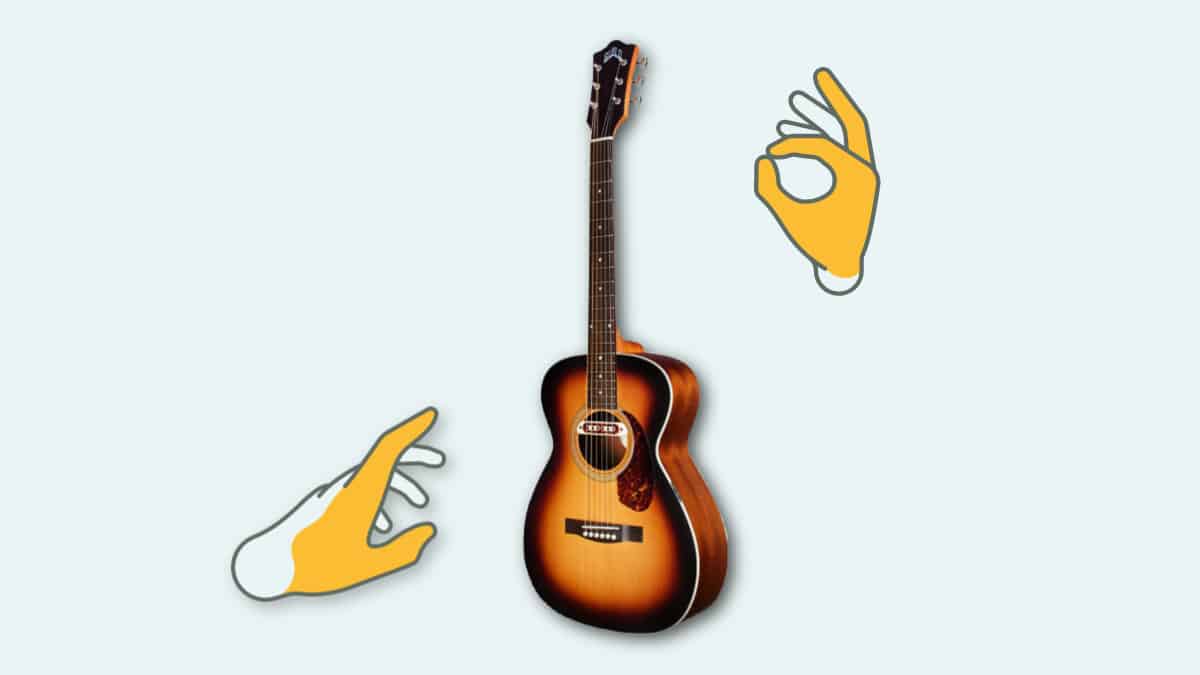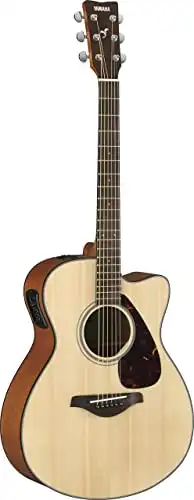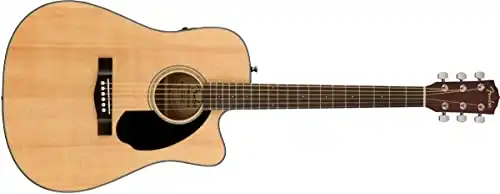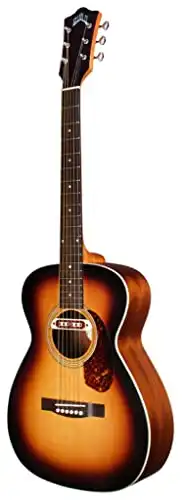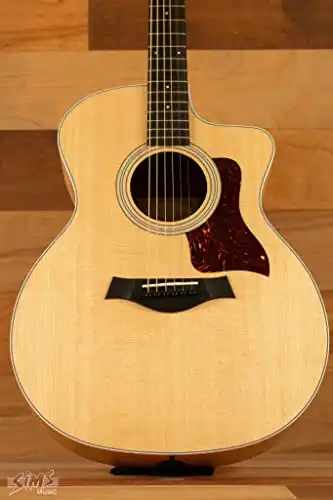Wanna cut to the chase? I went searching for the best acoustic guitar for fingerstyle, and my top choice is the Yamaha L-Series LL6 Acoustic-Electric Guitar.
Growing up, I spent a lot of time listening to classic rock and blues rock. I was a full-on bluesy rock guitarist and loved my electric. No acoustic for me!
Until I watched August Rush. If you haven’t seen it, I recommend you watch it today! Once I realized what amazing music you could make playing fingerstyle on an acoustic, I was hooked.
If you’d like to try playing without a pick, it’s a good idea to look for a guitar that’s well-suited for fingerstyle playing.
Today I’ll share my reviews of 5 guitars that I think would make good options for fingerstyle — including pros & cons of each — to help you find the best one for your needs.
I’ll also answer some common questions related to fingerstyle guitar.
Now, let’s dive in. 🙂
What Is Fingerstyle Guitar?
Simply put, fingerstyle is when you play guitar using just your fingers. No pick necessary!
Fingerstyle can be as easy or complicated as you want it to be. Plain fingerpicking has a clean, classic sound. But don’t think fingerstyle guitar is simple or boring. On the contrary! Check out Trace Bundy, Kotaro Oshio, or Justin King if you want some real inspiration.
Although most fingerstyle guitarists don’t use a pick, some of them choose to use a thumb pick in order to hit the bass notes more cleanly. It’s rare though, and depends on the exact style of play.
Fingerstyle is more common with guitars that use nylon strings. Playing fingerstyle on steel string guitars is a bit harder on the fingers–although it can sound great.
It’s not very common to use fingerstyle on electric guitars, although it can be done – Mark Knopfler is a prime example.
It’s also a common style amongst blues guitarists!
For even more inspiration, feast your eyes and ears on some of the best fingerstyle guitarists in the world today. Watching this video should give you a really good idea what this style entails:
What’s the Difference Between Fingerstyle and Fingerpicking?
The terms “fingerstyle” and fingerpicking actually overlap, and every type of fingerpicking could also be labeled fingerstyle. For example, fingerstyle covers all these fingerpicking approaches:
- Classical
- Flamenco
- Travis picking
- Percussive guitar
- Slide guitar
There’s a lot of variety!
But there’s also one key different between fingerpicking and fingerstyle:
Fingerpicking
It’s generally accepted that fingerpicking is a non-percussive style of playing.
The bass notes are plucked with the thumb, and the upper notes are played with the fingers. It’s common to include a mix of fingerpicking and strumming.
Fingerstyle
Fingerstyle, on the other hand, is often used to refer to a more percussive style of playing. This is a more textured style than fingerpicking, with many more layers.
The thumb plucks or slaps the bass note, while the other fingers play the melody, either by picking or strumming.
In some cases, the thumbs, fingers, nails, knuckles, and finger joints are all used together to create a beat on the guitar body (like in the video above).
Percussive fingerstyle can be more a performance unto itself, and not really something you’d use when casually playing campfire songs or jamming with friends.
Is fingerstyle guitar the hardest Way to play?
Based on my own experience, I would actually say picking with a guitar pick is more challenging than picking with your fingers.
Basically, when I do fingerpicking I can feel the strings directly on my fingertips, so I get that tactile feedback. But when I’m picking with a plastic pick (or a more unique type of guitar pick), I can’t feel the strings directly. That makes it a little bit easier to miss a string or hit a wrong note.
Overall, I think picking smoothly and consistently with guitar picks has a little higher degree of difficulty then playing fingerstyle.
What to Look for in a Fingerstyle Guitar

Can you play fingerstyle on an acoustic guitar you already own?
Sure you can. I started out with an old beat-up classical guitar!
But the best guitars for fingerstyle have some particular features.
If your guitar ticks all these boxes, that’s great! If not, and you’re serious about fingerpicking, you may want to invest in a second guitar.
If you’re buying for the first time and you want a proper fingerstyle guitar (that you can still play with a pick if you really want to), here are two factors you should consider:
Smaller Size
Firstly, a smaller body is more comfortable for many guitarists. It’s easier to hold, and lighter if you want to play while standing.
Many smaller-bodied instruments also have a shorter scale length (roughly the distance from the sound hole to the tuning pegs).
This usually means that the guitar strings are not stretched as tightly, making them easier to hold and more responsive to touch.
Check out our reviews of the best 3/4 acoustic guitars for some options that may be a good size.
Wider Space Between Strings
The important thing to look at here is the nut width.
The nut is the part at the end of the guitar neck, where the strings sit in little grooves.
Most finger-players agree that a nut of 1¾ inches is ideal.
It allows for just enough space between strings that you can get your fingers between them comfortably without accidentally bumping other strings.
Tonewoods
Guitars made out of certain types of wood are better sounding than others. This is because they create better resonance (when the air in the guitar body amplifies the volume of the vibrating strings).
Some woods that are great for fingerstyle guitars include:
- Spruce
- Cedar
- Mahogany
- Koa
How to Play Fingerstyle Guitar
Having a good guitar for fingerstyle is great, but learning how to play it properly is important too.
Take a look at one of the most well-known fingerstyle players, Tommy Emmanuel, explaining four essential steps to playing great fingerstyle guitar.
Once you’ve mastered those, you can work on adding in some percussion!
[REVIEWS] Best Acoustic Guitars for Fingerstyle
Top Pick: Yamaha FSX800C Small Body Acoustic-Electric Guitar
Yamaha makes some super acoustic guitars.
Yamaha’s FSX800C has a classic look and some nice features.
It also gets a thumbs-up as a good value for money.
This particular instrument has a smaller-than-normal body, which is comfortable and easy for just about anyone to play.
It also has a cutaway, so it’s easier to reach the higher notes.
With a nut width of 1 11/16 inches, it’s ever so slightly short of the 1 ¾ inch sweet spot–but it’s close enough to be a good width for fingerpicking.
Another big bonus of this guitar is that it’s acoustic-electric, which means you can plug it into an amp if you want a bigger sound.
You can also choose to purchase a value pack, which includes a tuner, strap, string winder, guitar wipe cloth, and picks (which are nice to have even if you want to play fingerstyle).
(If you do choose to buy the value pack, be aware that the cutaway shape isn’t available with the pack – only the regular shape.)
On the downside, some of these guitars come with strings that are raised quite high off the fingerboard (a high action), so it’s possible you would need to lower them for you before you start.
Overall, this is my top pick for best fingerstyle guitar because of the excellent sound quality, reasonable price, small body size, acoustic-electric pickup, cutaway, and option for a value pack.
What I Like
- Excellent sound quality
- Smaller body size
- The cutaway helps reach higher notes
- Acoustic-electric
- Fair price
What I Don’t Like
- May need adjusting to get the action right for you
- Cutaway shape not available in the value pack
Runner-Up Pick: Martin LX1E Little Martin Acoustic-Electric
Martin guitars are renowned for being high-quality, and this one comes in top spot for the best Martin guitar for fingerpicking. If you’re not convinced, this is the model Ed Sheeren chooses to play!
It’s called the Little Martin for a reason. This guitar sports all of Martin’s high-end features in a little body, which makes it very comfortable to play on.
The small size can also be convenient for travel.
There’s no cutaway on this one, making it a little harder to reach the higher frets. But the small size of the body makes it pretty easy to reach up the neck anyway.
Just like the previous option, it features a 1 11/16 inch nut, which when combined with the compact body, makes this guitar a good fit for fingerstyle.
It’s versatile, having built-in electronics so you can play it around the campfire or on stage.
The tuner is located inside the sound hole, which may take some getting used to.
What I Like
- Excellent sound
- Acoustic-electric
- Smaller body size
- Comes with a soft gig bag
- Built-in tuner for convenience
What I Don’t Like
- To adjust the neck, you’d need an extra-long allen wrench
- No cutaway
Budget Pick: Fender CD-60 Acoustic-Electric Guitar
Fender is probably the most well-known guitar brand. Don’t think that all Fenders cost a fortune, though – this one is my best budget pick.
You can choose between an acoustic (CD-60) or an acoustic-electric (Dreadnaught SCE).
The acoustic is a regular body shape that comes in three different finishes so you can find a style you really like.
It comes with a hard case too, to keep it safe when you’re traveling or between playing.
The acoustic-electric comes with a cutaway, which is convenient for reaching higher notes.
It features an in-built pickup with a tuner, but it doesn’t come with a bag.
Both of them are built with a solid spruce top, which is one of the woods that really creates great resonating sound.
They also both have a rolled edge on the fretboard, which means that the edges of the wood are smoothed to a curve, so they’re not sharp at all. This is an added comfort feature!
It also has the ideal width nut for fingerstyle guitar – 1 ¾ inches.
All of these features, plus it’s very decent price (whichever style you choose), land it on top of the pile for budget-conscious guitarists.
What I Like
- Very reasonably priced
- Choose from acoustic-electric or acoustic
- Cutaway option
- Ideal 1 ¾ inch nut width
- Rolled fingerboard edges
What I Don’t Like
- The SCE cutaway doesn’t come with a case
- The placement of the strap stud means it’s not easy for a left-hander to play this guitar standing up
Most Unique Pick: Guild M-240E Troubadour Acoustic Guitar
This eye-catching guitar is a great choice for guitarists who like something a little different.
It’s a bit of a gem when it comes to fingerstyle guitars specifically, sporting many of the “must-have” features.
Like the others on the list, it has a smaller body for ease of playing.
As well as being compact, the body is crafted from a mix of spruce and mahogany – both fantastic tonewoods. This gives it a big sound for such a little body.
The soundhole pickup is also unique. It’s removable, which is useful if you feel you don’t need it, but it’s great if you are planning on playing through an amp.
Interestingly, it’s a passive pickup, which means it doesn’t need battery power. But this also means you don’t have much control over the tone it puts out – it’s basically just a guitar microphone.
This particular pickup placement is something that’s often only seen on customized guitars, so it’s pretty cool.
Considering the richness of the tone, the nice-sized guitar body, and the uniqueness of the pickup and the sunburst finish, it wins first place for the most unique guitar for fingerstyle players.
What I Like
- Compact body size
- Made from superb tonewoods
- Comes in natural or sunburst finish
- Unique soundhole pickup
What I Don’t Like
- Doesn’t come with a case or bag
- Not much control over sound with the pickup
Upgrade Pick: Taylor 214ce Grand Auditorium
If you want to upgrade from a beginner or intermediate acoustic guitar to a high-end one, Taylor is one of the brands you should definitely be looking at.
They make beautiful acoustic guitars, like this unique-looking and well-crafted Grand Auditorium.
The body consists of spruce and Koa, two tonewoods that are well-known for their amazing sound.
Taylor uses a unique electronics system, and the controls are designed to be small and unobtrusive, which I really like.
It’s a full-size guitar that has a bit of a larger body than the others I’ve reviewed, but it plays like a true Taylor dream.
I’ve chosen this beauty as the best Taylor guitar for fingerstyle, and my top upgrade pick.
(PS: It could also be a great option if you’re looking for the best acoustic guitar for fingerstyle blues.)
What I Like
- Constructed from Sitka spruce and Koa wood
- Unique cutaway style
- Acoustic-electric
- Lightweight – easy to hold or carry
What I Don’t Like
- It’s quite a bit more pricey than the others on this list
- The body is a little bigger than others I’ve reviewed
Conclusion
Fingerstyle is a really fun way of playing that every guitarist can and should learn. Find yourself at a friend’s house without a pick? There’s nothing stopping you from picking up their guitar and playing if you’ve mastered fingerpicking.
If you’re really interested in learning to play with just your fingers, the best guitar for fingerstyle and strumming should have a smaller than average body and a wider than usual space between the strings.
I’ve compared five solid choices in this article. All that remains is for you to decide which you like most, or go out and find your own guitar based on the factors that makes a great fingerstyle guitar!
My first choice for the best acoustic guitar for fingerstyle is the Yamaha L-Series LL6 Acoustic-Electric Guitar. It has a nice compact body, can be played acoustic or plugged into an amp, has a well-rounded sound quality, and comes at a decent price.
The rest of the guitars on the list are solid options, and there’s something for every kind of guitarist. I hope you find the right one for you and get started on the journey of learning how to play fingerstyle!
Thanks for reading!






